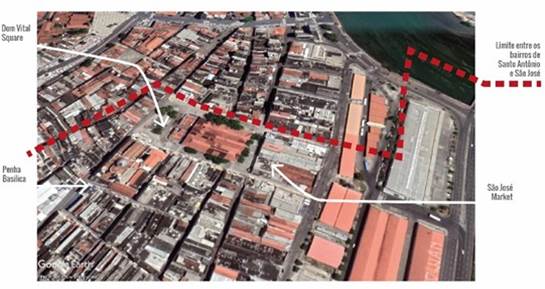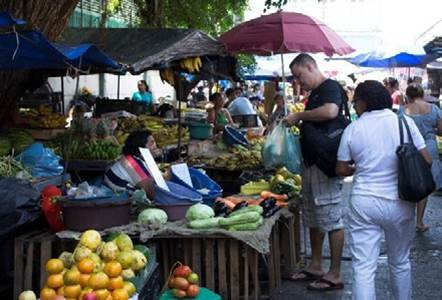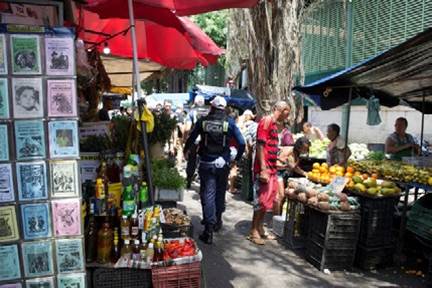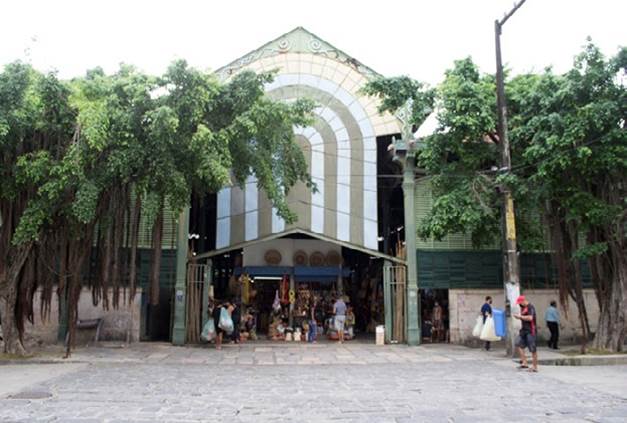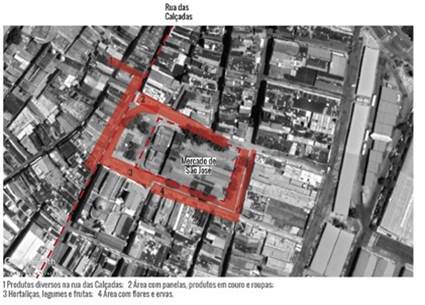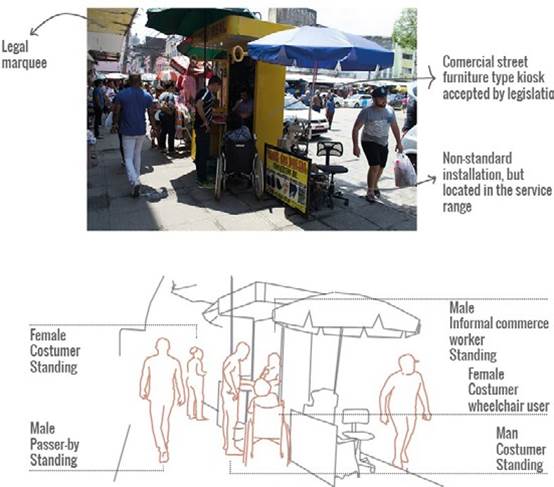Serviços Personalizados
Journal
Artigo
Indicadores
-
 Citado por SciELO
Citado por SciELO -
 Acessos
Acessos
Links relacionados
-
 Similares em
SciELO
Similares em
SciELO
Compartilhar
Revista Lusófona de Estudos Culturais (RLEC)/Lusophone Journal of Cultural Studies (LJCS)
versão impressa ISSN 2184-0458versão On-line ISSN 2183-0886
RLEC/LJCS vol.8 no.1 Braga jun. 2021 Epub 01-Maio-2023
https://doi.org/10.21814/rlec.3198
Thematic articles
City and Performativity: Normative Ruptures in the Informal Public Space - A Case Study in the City of Recife, Brazil
1 Universidade Federal de Pernambuco, Recife, Brasil
By questioning the idea of a hegemonic city and with totalizing structures, this article takes the bodies in the urban space as a way to argue the normative structures and, therefore, seeks to investigate the thinking of the city for various performativities, by taking into account bodies beyond certain normatives. To this end, the concepts of performativity of the philosopher Judith Butler (1990/2020) and the concepts of micropolitics and macropolitics of the philosophers Gilles Deleuze and Félix Guattari (1980/1996) are used for the interpretation and construction of the research, through which it was possible to understand the segmentation of the everyday doing. Those segments can be characterized as linear (the historical processes), circular (the territory occupations) and binary (the social dualities). The application process in the field of the concepts studied was carried out in Brazil, in the city of Recife, and the area chosen was the surroundings of the São José market, located in the historical center, where existed an intense informal trade activity until 2019. The investigation was structured in interpreting how some of the social segmentarities of this space conform, with the objective of characterising the relations of spatial appropriation by the performative bodies. Consequently, the enunciation of a concept was reached as a result to characterize the relationship between the bodies and the observed area: the disruptive performative spaces. Therefore, this work seeks to contribute to the practice of urbanism, by proposing a more inclusive look at the city.
Keywords: bodies; city; performativity; Recife; segmentarities
A partir do questionamento da ideia de uma cidade hegemônica e com estruturas totalizantes, este artigo toma os corpos no espaço urbano como um modo de discutir essas estruturas normativas e, por isso, procura investigar como pensar a cidade para as diversas performatividades, ao levar em consideração os corpos além dos determinados normativos. Para tanto, são utilizados como fios condutores de interpretação e construção da investigação os conceitos de performatividade da filósofa Judith Butler (1990/2020) e os de micropolítica e macropolítica dos filósofos Gilles Deleuze e Félix Guattari (1980/1996), através dos quais se chegou ao entendimento da segmentação do fazer cotidiano. Esses segmentos podem ser caracterizados como linear (os processos históricos), circular (as ocupações do território) e binário (as dualidades sociais). O processo de aplicação em campo dos conceitos estudados foi realizado no Brasil, na cidade do Recife, e a área escolhida foi o entorno do Mercado de São José, localizado no centro histórico, onde existiu, até ao ano de 2019, uma intensa atividade de comércio informal. A investigação estruturou-se em interpretar como se conformam algumas das segmentaridades sociais desse espaço, com o objetivo de caracterizar as relações de apropriação espacial pelos corpos performativos. Diante disso, chegou-se como resultado à enunciação de um conceito para caracterizar a relação entre os corpos e a área observada: os espaços performativos disruptivos. Dessa maneira, este trabalho busca contribuir para a prática do urbanismo, ao propor um olhar mais inclusivo sobre a cidade.
Palavras-chave: cidade; corpos; performatividade; Recife; segmentaridades
Introduction
A convenient way to get to know a city is to try to find out how you work in it, how you love it and how you die in it. In our small town, is it the effect of the climate, all of this is done together, with the same frantic and absent air. (Camus, 1947/2017, p. 7)
From this excerpt from Albert Camus (1947/2017), A Peste (The Plague), several possibilities can emerge about how to think of ways to get to know a city. However, one thing common to the moments of life brought by the writer - work, death, and love - is the corporeality as an indispensable category for the existence of urban subjects. The body, through its materiality and perception, is the means by which the subject is able to absorb his experience in the city and perform it in his daily life. The relationship between the body and the city is indispensable in the constitution of the urban subject, and this relationship works in a reciprocal way, because at the same time that the city is experienced through the body, the body is responsible for making the city.
To think the city on this bias, we took the concept of performativity developed by the American philosopher Judith Butler (1947/2017), through which approaches the body with a political look, by taking into consideration these marks left by social and cultural structures, and allows us to think the city through the body. Butler (2015/2019) defines the concept of performativity as an ontological representation performed by the body and characterizes it as a way of acting in society: “it is a matter of acting, and in acting, claiming the power one needs. That is performativity as I understand it, and it is also a way of acting out of and against precariousness” (p. 65). Therefore, the author questions through performativity the bodily standards determined by a society ruled by a central power, which seeks to control any kind of diversity, be it racial, gender, or class. Here, the standards are understood as a normativity determined by the powers existing in society, which end up discriminating or excluding some bodies from the “legitimate” structures of social organizations. The “powers” can be both administrative structures and body representations determined by traditions, imaginaries and consumption.
These standards, acting on both the body and the production of the city, can be approached from the understanding of the micropolitics and macropolitics presented by philosophers Gilles Deleuze and Félix Guattari (1980/1996). For the authors, “everything is political, but all politics are at the same time macropolitics and micropolitics” (Deleuze & Guattari, 1980/1996, p. 90). Therefore, micropolitics corresponds to the portion of politics related to the desires that move a society individually and collectively. It is flux and intensity. Macropolitics, on the other hand, is related to the totalizing and visible structures of politics. It is the flow of micropolitics channeled and sedimented as a large social structure. According to the philosophers, micropolitics and macropolitics coexist in society and together make up the various existing social and political structures.
Through micropolitics and macropolitics it is possible to measure an interpretation of the relationship between the performative body and the city, considering a look towards imposed normativities. Through their bodies, social groups question a production of city that starts from a totalizing perspective, of an ideal man; this ideal city “has a single gender, race and sexuality that regulate everything, including our imaginary” (Moreira & Nisida, 2019). In this way, crossed by these questionings and context, we sought to investigate new possibilities of approaching the city, to reflect on how to think the city for the diverse performativities, by taking into account the bodies beyond the determined normatives.
In a context of reformulation of strategies to think the city, whether these strategies are more reactive or propositional, this text stands as a reflective process to think the city, from the bodies that occupy it and the normative political forces that cross it. A way to look at urban spaces through new lenses and help build a more welcoming city. In this sense, first, a theoretical construction and a crossing of the key concepts for the construction of the research are made: the performative body, macropolitics, and micropolitics. Then, the research carried out in a Brazilian context, the surroundings of São José market, is exposed. Finally, the results achieved and the reflections resulting from our discussion and observation in the production of urban space are discussed.
To this end, the study was applied in the Brazilian context, more precisely in the São José market block, in the city of Recife, Pernambuco. The block is cut across two neighborhoods, Santo Antônio and São José, and is located in a historic area of the city. Until 2019, it had a large circulation of people daily, mainly due to its strong popular and informal commerce. But in 2020, the city government removed informal trade workers from the area, which decharacterized the space for the purpose of “zoning” and for the creation of parking spaces. It is also worth highlighting our decision not to have investigated the internal space of the market, preferring to observe the bodies without the im position of an architectural program of uses, since the research1 turned to the relations between performativity and the city, especially those related to the appropriation of pub lic space by informal commerce workers.
City, Body and Politics: The Structures Embedded in the Constitution of the Subject
As pointed out by philosopher Maurice Merleau-Ponty (1945/2006), the body is the means through which the subject relates, processes and inhabits the world. Therefore, a perspective to look at the relationship between the body and the city is the reading made by sociologist Richard Sennett (1994/2008), who presents the construction and the organization of cities based on the body. The author points out how the several social, historical and political issues that permeate the body reflect in the arrangement of urban space throughout Western history. In fact, Sennett (1994/2008) points out how the dis- solution of a dominant image of body in urban space is responsible for enabling multiple existences - racial, social and gender - to live together in the same place and thus provoke “changes that have tarnished and subverted the urban form and space” (p. 23).
In the Brazilian context, through the discussion brought by Sennett (1994/2008),
it is possible to understand the aversion to the streets of the wealthier social classes, especially in cities with colonial origins, and why the logic of production of Brazilian cities still promotes a city focused on private space. The architect and urbanist Lúcia Leitão (2014) shows the origins of this problem. According to Leitão, the beginning of the development of Brazilian cities with colonial origins represented a loss of power and control of the plantation owners, an oligarchic elite that came from sugarcane agriculture. This loss occurred due to the characteristics of urban life, such as anonymity and collectivity, “in many ways incompatible with the interests of the patriarchal lords of colonial Brazil” (Leitão, 2014, p. 78). In other words, being in the city would mean, in a way, a greater freedom to the bodies, especially to women, free workers, and former slaves, after all, they would be outside the visual control of the plantation owner. However, the customs and the power still concentrated in the hands of the plantation owners were enough to build an idea of the street as something depreciated and frightening for women and children, being this space destined only for men. Today, some aspects of these ideas still inhabit the imaginary of many residents of Brazilian cities.
A key concept to look at corporeality as something contextual - in relation to society and urban space - is that of performativity. The performativity, as treated by philosopher Judith Butler (1990/2020), addresses precisely this understanding of the process of construction of a body crossed by historical, cultural and social issues and was chosen as a guiding concept in the research process of this work. As a way to understand the process of affectation of the body by the city, and the city by the body, the concepts of micropolitics and macropolitics were taken. Therefore, we now proceed to the understanding of what performativity is in Butler and the concepts of macropolitics and micropolitics brought by Deleuze and Guattari (1980/1996).
Performativity and Its Political Condition
The word “performativity” was first used by the philosopher of language J. L. Austin in 1955 to denote verbs that express actions through acts (Butler, 2015/ 2019). The verb swear, for example, a speaker when he says it in the first person, he is also performing the act. Judith Butler (2015/2019) establishes a relationship between Austin’s performativity and the process of constructing corporeality. For the philosopher, the action of naming something transfers to the “thing” various meanings and characteristics. For example, when a baby is born, and the doctor - or someone - declares that it is a girl or a boy, automatically several aspects of our imaginary are transposed to that human being. Among these aspects is how the body represents the female or male gender through its gesticulation. Thus, the categorization of something through naming is responsible for imprinting performative marks on its corporeality. Butler (1990/2020) builds her definition of the concept of performativity on this connection between language and the body, but is equally influenced by Simone de Beauvoir’s feminist and existentialist theory and Maurice Merleau-Ponty’s phenomenology.
Simone de Beauvoir (1949) contributes to the concept of performativity, mainly through her ideas discussed in the book Le Deuxième Sexe: Les Faits et les Mythes , work in which her famous phrase was published: “one is not born, but rather becomes, a woman”. From the distinction between sex and gender, Beauvoir sees gender as something socially constructed. However, Beauvoir (as cited in Butler 1990/ 2020) understands its construction as a “cultural compulsion to do so” (Butler, 1990/2020, p. 29). Therefore, Butler (1990/2020) points out some caveats, such as the need to conceive of a body no longer as a medium or passive. It is important to remember the existence of the possibilities of performative ruptures, in the question of gender and in other dimensions. According to Butler (2015/2019), these ruptures are mainly present in groups gathered with lives marked “by induced forms of precarious condition” (p. 17), that is, any body not legitimized by the acting power structures.
The aspects of body movement in the concept of performativity come, in large part, from the philosophy of perception developed by Merleau-Ponty (1945/2006). The philosopher is responsible for introducing the corporeal dimension into phenomenology, from a search for the essence of perception, in which he argues that the body is a unity and, as such, processes the world in a total way, through the whole being. Thus, the body is the instrument through which the being inhabits the world and constructs its point of view about it. In inhabiting the world, the body relates to the objects existing in it and is responsible for producing points of view about these objects according to their contexts.
From these theoretical-conceptual constructions, one can objectively arrive at a definition of the performative body as a stylized repetition of gesture (of action), and this repetition is what guarantees people a certain corporeal individuality, which can be actualized. Moreover, it is important to add the conception of the performative body as the expression of the embodied external, since even though the person has his or her own particularities, there is an embodied political structure that is transformed into a social symbol through performativity. It is in this trajectory of thought that we identify a conception of performativity, elaborated from the counterpoint between the notions of agency and reproduction. While the idea of agency refers to the possibility of awareness, of capacity for action, of moral and political autonomy of the subject, the idea of repro- duction brings with it the paradox of the subordination of this same subject to power relations, considering the influence of external political forces in performativity. And one of the main aspects of performativity is its political character, because the external embodied structures are loaded with censures, prejudices, and norms. Therefore, the performative can have a transformative and questioning stance on reality.
Although this study takes a concept of the performative from gender studies, it is intended to promote the possibility of its expansion to several fields of social life. After all, “while gender cannot function as a paradigm for all forms of existence that struggle against the normative construction of the human, it can offer us a starting point for thinking about power, performance, and resistance” (Butler, 2015/2019, p. 45). We now move on to a possibility for interpreting the political structures that run through the body and how these structures can conform a pattern for interpreting the city, from a gaze that welcomes performativities.
Micropolitics and Macropolitics: A Reading for the Compositions of Performativity
There are several ways to understand how lifestyles are shaped in societies, among them is the look brought by Gilles Deleuze and Félix Guattari (1980/1996) through micropolitics and macropolitics. In a post-structuralist context, focusing on an interpretation of ways of life, these authors sought to question the standardization and exalt the multiplicity of social practices. For this, the philosophers begin with a fragmented view of social conformation: life composed of various segments and this segmentarity as a characteristic present in all types of society, from the so-called primitive ones - without the presence of a state - to the contemporary ones. Segmentarities are understood as the “doing segments” of everyday life. For example, “how you work in it, how you love it and how you die in it” (Camus, 1947/2017, p. 7).
In the regency of the configurations of ways of life, the authors identify three types of segmentarity: binary, circular, and linear. Binary segmentarity refers to the great social dualisms, such as man and woman, old and young, white and black, bourgeois and proletarian, and so forth. Circular segmentarity functions as zones that can be associated with both space, as in “my occupations, the occupations of my neighborhood, my city, my country, the world...” (Deleuze & Guattari, 1980/1996, p. 77), as well as the action zones of everyday life, for example a person circulates between family, professional, social, educational zones. Finally, linear segmentarity works as line segments representing an episode or a process, which can be historical, political, and social and represent relevant facts for a country or in a personal trajectory. It is important to note that these forms of segmentarity do not exclude or compete with each other; on the contrary, they coexist.
Thus, it is worth highlighting how segmentarities are different in distinct societies. Deleuze and Guattari (1980/1996) discuss these different manifestations of segmentarity by contrasting primitive societies with those with a state (Figure 1). In primitive societies, for example, segmentarity can be characterized, in general, as supple, because, despite presenting binary compositions, it comes from multiplicity; its circles are not concentric and its lines are an expression of freedom. As for modern societies - which have the presence of a state - segmentarity is interpreted as rigid, because its binary compositions originate from a machine of binarization, its circles have a center of power, and its lines are overcoded. The government functions as a resonance machine of lifestyles. Thus, the authors state that primitive societies are in constant transformation, while modern societies have less malleable and more consolidated structures.

Credits. Lígia Dias
Figure 1: Schematic to Represent Segmentarities in Primitive and Modern Societies
The segmentarities with rigid characteristics result in macropolitical processes, because their political structures are more consolidated, legitimized, and visible in the social environment. Macropolitics is responsible for constituting the individual through units, such as in the case of binary oppositions, and for reducing multiplicity into totalizations. In contrast, micropolitics is the invisible part of politics, because it is the desires and wills that move the subjects in society. It is intensity, rather than unity. Hence, micropolitics is related to segmentarities with supple characteristics. It is important to emphasize the need to not make value judgments between micropolitics and macropo litics, because both are essential parts for the consolidation of any process of desire and transformation.
The city project and the performativities that occupy it are not disassociated from macropolitics and micropolitics. The architect and urban planner Igor Guatelli (2012) comments on how the rigid structures of ordering of a place are used to control the social performance, because, normally, the design conception proposes a correct space “governed by conventional programmatic prescriptions and pre-determinations of uses” (p. 16). According to Guatelli (2012), this is the product of a functionalist discourse program, “an ideology was created and, with it, the formulation of a new prescription of social behavior” (p. 30). Nevertheless, there are the possible gaps in this rigid system, which the author calls the in-between. It is possible to associate the in-between with micropolitical aspects, with what escapes the control of totalizations, because the in between would be the indeterminate space, open to new meanings and interventions, “it is about considering the project not as an end, but as a means” (Guatelli, 2012, p. 41).
The in-betweens that are found in the city survive through the bodily presence affected by that space. Occupying a space affects and is part of the performative construction of the subject, since urban spaces are full of historical and social meanings and are reflections of the current system. Moreover, the performative body is political and, consequently, can be understood through segmentarities, which can coexist between the body and the city. The normative ruptures of performativity are micropolitical expressions that escape totalizations and often clash with the social structures responsible for producing homogenizations.
Thus, to investigate the relations of appropriation of public space by the various performativities, this article is based on the characterization of some of the segmentarities that existed in the surroundings of the São José market, in the historic center of the city of Recife, before the removal of the informal commerce workers by the city hall. For this, through the linear segmentarity, a historical characterization of the users and legislation of the area was made. In relation to circular segmentarity, the forms of occupation of the public space by the bodies were observed. And finally, through the binary segmentarity, the dualities that tangent the body, the public space, and the legislation were identified.
Field Assignment: The Informal Occupations Around the São José Market in Recife
The neighborhood of São José is one of the initial settlements of the city of Recife, with historical characteristics and a commercial and popular area. Therefore, investigating the performativities of this public space was mainly to look at the informal commerce workers and their clients, who were the main occupiers of the area. Thus, we proceed to an observation based on the segmentarities of the space and the performativities that occupy it. For this, in addition to the concepts and authors already brought in the text, the view of the sociologist Pierre Sansot (1971/2004) was important for the observation of the relationship of the bodies with the space, mainly because it deals with the influence of intimacy in spatial appropriation.
Linear Segmentality
From some processes that compose the linear segmentarity of the São José market surroundings, in Recife (Figure 2), we tried to contextualize the history of the formation of the place; to characterize some user groups of the area; and to bring some active legislations. With this information, we began to understand how the informal commerce occupation structures that existed in the space were constituted and the performativities that conformed and were conformed by them.
The São José neighborhood is one of the first occupied areas of the city of Recife. Its occupation process began in the first half of the 17th century with the Dutch invasion. The former Antônio Vaz island, where the neighborhoods of São José and Santo Antônio are located today, was chosen to be the place where the center of the Dutch occupation would be built (Figure 3). This choice was made due to the existence of a housing deficit for the less wealthy population, especially the employees of the West Indies Company, a Dutch trading company, and to facilitate “communication with the rest of the continent” (Menezes, 2015, p. 81).
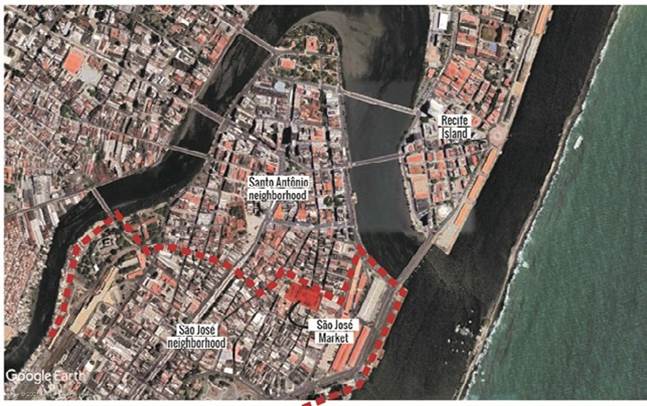
Credits. Edited by Dias and Leite
Figure 3: Map of the Former Antônio de Vaz Island, Now Santo Antônio and São José Neighborhoods
The occupation of the island was planned by Dutch architect Pieter Post with an urban plan, in 1639. The plan included the construction of two bridges, connecting the island of Antônio de Vaz and Recife - port nucleus and initial occupation - and the residential, commercial and institutional uses. In the northern portion of the island - present-day Santo Antônio neighborhood - institutional and commercial uses were implemented, while in the southern part - present-day São José neighborhood - residential use prevailed, which was intended for a poorer population (Menezes, 2015).
In the 19th century, the neighborhoods of Recife, Santo Antônio and São José were already densely populated. A process of expansion and modernization of the colonial neighborhoods began. To this end, the urbanistic actions sought the installation of a set of equipment in Recife, Santo Antonio and São José neighborhoods in order to consolidate the image of the city center. Among these equipment was the São José market (1875), which was installed where there was already a street market, and was made in iron architecture. From the 20th century on, the wealthier layers of the population started shopping in the new supermarkets in the suburbs, and the São José market continued to be used by a less affluent population.
Currently, the area remains extremely commercial and, until 2019, the streets between the market block were occupied predominantly by customers and workers from the informal commerce, which still added to the local atmosphere the coexistence between the formal and the informal (Figures 4 and 5). These bodies built a language of the street, expressed throughout history, and the configurations of political flows that operated there --governed both by municipal and federal laws, and by the logics of informal occupations. In this way, merchants and workers, mixed with users attracted by the merchandise, participated in the construction of a cultural-historical narrative of the neighborhood, determined by collective practices, experiences, and memories of the place.
As discussed by Merleau-Ponty (1945/2006), language can be gestural, and so is the configuration of the language of the street discussed in this research. Users perform their role according to the place they are in, in this case, the São José market block. After all, outside the home, “we are no longer husbands, wives, or children, but men and women who speak strongly, as they breathe, walk, and digest” (Sansot, 1971/2004, p. 266). In the street, the bodies are not submitted to a family structure and can free themselves from some of these bonds. This understanding converges with the discussion brought by Butler (2015/2019) about the body in public and private spaces. For the author, the body in private space is passive, while in public space it has the capacity for action and political transformation through performativity.
From the historical contextualization of the area and the observation carried out in the field, some predominant groups of users were identified. They are: informal commerce workers, customers and passersby in the area. The informal commerce workers - daily occupants - had a greater intimacy with the space, which ended up producing more relaxed and agile performativities. The informal commerce workers dictated the rhythm of the area and the times of greater intensity of space use. According to Sansot (1971/2004), the intimate knowledge of the street provokes a sense of ownership of the space, because the subject starts to have a more authoritative attitude in relation to the events of the space.
The customers needed to follow the rhythm and adapt to the manner of the informal commerce workers. The customers who were more familiar with the place could interact in a more harmonious way, even incorporating in their performativities the rhythm of the informal commerce workers in their walk and gesture. In contrast, sporadic visitors to the area moved more calmly, especially tourists who, according to Sansot (1971/2004), have “an air of being dominated” (p. 265) by the space; they lack the familiarity to feel comfortable. The passers-by were the people who circulated without interacting with the commerce around them. They used the area as a passage for their personal journeys and, therefore, usually did not carry bags or have an attentive posture or look at the merchandise around them.
Another important aspect, according to a perspective of linear segmentarities, are some laws established by the state at the municipal and federal level and active in the area, because these legislations also unfold as a way to control aspects of the body’s performance. One of the most comprehensive impositions in terms of space for the Santo Antônio and São José neighborhoods is the division of the city into political administrative regions (RPA). The Santo Antônio and São José neighborhoods belong to RPA 1, which takes in the entire nucleus of the city’s initial formation. In addition, these neighborhoods are a special zone for preservation of historical and cultural heritage, with the objective of preserving both some representative buildings from the 18th to 20th centuries, and the “primitive layout of the urban design in certain stretches” (Law No. 16.176/96, 1996). It is important to point out that the building of the São José market is federally protected, since its centennial, in 1973, for preserving its iron structure and for being the oldest prefabricated building in Brazil (Figure 6).
Other important laws2are also worth mentioning here, as they add issues to the discussion about the normative layers. Among these laws, the municipal ones deal mainly with issues related to the limits between the sidewalk and the buildings and the obligations of the property owner with the maintenance of the sidewalk. The federal regulation, on the other hand, recommended by the municipal law as a model for the project, addresses and details more the aspects related to the sidewalk design, by guiding for the universal design3 (ABNT, 2015).
Circular Segmentarity
From an interpretation of the area according to some circular segmentarities, we could understand some logical patterns of space occupation by its users. As seen, one of the predominant user groups was the informal commerce workers, responsible for occupying the space in a more fluid and less regulated way. Therefore, understanding the log ics of occupation around the São José market was for us to understand the clash and coexistence between formal and informal interventions built through the performative body.
The historical location of the street market in the neighborhood drove the creation of the São José market, still in the 19th century. Consequently, nowadays, the market functions as a centrality of popular commerce in the center of Recife and marked the installations of the informal commerce workers’ stalls, which occupied mainly the limits of the market building, but also the limits of the Dom Vital square, the streets that surround the block and the streets that lead to the market block. Thus, although the informal commerce stalls were not legalized, they were installed from a center of attraction of the formal city structure, the São José market, in other words, according to a concentric logic of occupation, relating to a macropolitical structure (Figure 7).
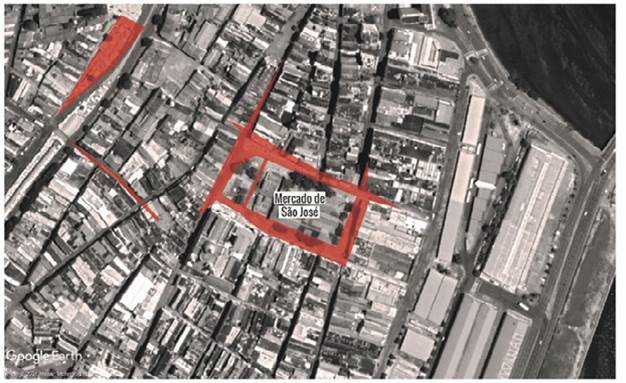
Credits. Edited by Dias and Leite (2021)
Figure 7: Occupation Spots of Informal Trade Until 2019 According to Their Density
Even with a conformation of circular segmentarity in a rigid way in relation to a macro view of the area, it is worth remembering how the various segmentarities always coexist, and this is no different in the area studied. By directing our gaze to a smaller scale
- the actual clipping of our observation in the city -, it was possible to perceive several circles of higher density with distinct centralities, coming closer to an organization with a micropolitical logic. The informal commerce workers occupied the existing in-between in the formal space: areas open to new possibilities according to the appropriation made by the population. These areas are regulated by the state power, but the occupation of the stalls overcame the normative forces, until the moment of their complete removal.
One way to look at the occupation of the in-betweens around the market by informal commerce workers is from the constitution of their performativities. The spatial occupation of the in-betweens by informal commerce workers is possible thanks to a collective performativity. From Hannah Arendt, Butler (2015/2019) talks about the power of collectivity to create in public space a location. For Butler (2015/2019), this location is realized by a performativity that claims its rights: “the claims of bodily action, gesture, movement, congregation, persistence, and exposure to possible violence” (p. 84). Moreover, performativity as a collectivity happens in-between bodies, “a space that constitutes the gap between my own body and that of the other. In fact, action emerges from the in-between, a spatial figure for an action that both binds and differentiates” (Butler, 2015/2019,p. 86). In this way, the occupation of the in-between places in the studied área also reflects a relationship of the performative constitution of the group of informal trade workers.
For the most part, the occupation of the informal trade stalls in the in-betweens of the studied area was established on spatial boundaries and thus the area’s public and private buildings - most of which are shops - and Dom Vital square were tangential. Although the occupation behaved in a rhizomatic way in relation to spatiality, because they were located in the in-between places, the stalls had a relatively rigid organization in relation to the distribution of the commercialized items, because it was possible to fragment the area according to the types of goods sold in the densest concentrations of stalls. They are diverse products; cookware, leather products and clothing; vegetables, legumes and fruit; and flowers and herbs (Figure 8).
The circular type segmentarities that existed in the area studied show how the various ways of conforming a segmentarity coexist. They always arrange themselves and compose the peculiarities of each social organization. In the case analyzed here, initially there is a concentric organization, the São José market is taken as the center of occupation and attraction by workers and users of the area. Then, the informal commerce workers, from a decentralized logic and originating from their performative constitutions, occupy the free spaces bordering the public equipment and stores, the in-between. However, the way these workers structure and locate their stalls is guided by the type of merchandise commercialized and each type of merchandise works as a center of attraction for occupation. In this way, Figure 9 tries to synthesize, through a graphic scheme, the coexistences between micropolitical (decentralized) and macropolitical (one center) structures in the spatial occupation of the area. It is worth reinforcing how the various conformations of segmentarities work together and permeate the various aspects of society, including the structures of the city and their influence on the performativities of its users.
Binary Segmentarity
From the understanding of the dualities existing in binary segmentarities, we seek to characterize aspects of the relationship between the body and the study area, to interpret the relations of appropriation of urban space by performative bodies. For this, performativity, spatial structures and legislation will be related, such as planning and control of urban space. The main instrument for the characterization of this segmentarity was the photographic survey of the space and the creation of graphic schemes, exemplified in Figure 10. Thus, the process of characterization of binary segmentarity happens, initially, from the spatial fragments identified in the area through circular segmentarity (Figure 8). Then, the users of the area are identified as informal commerce workers, customers, and passers-by. The objective is to evidence the relation of the bodies with the existing spatial structures and observe them through the acting norms.
Calçadas street, located to the west of São José market, is mainly occupied by stores and is very frequented by users of the region, because, besides the supply of products, it is one of the main streets connecting São José market to the bus stops and nearby parking lots. In almost all its length, Calçadas street was occupied by informal commerce stalls. Reading the photos, one could see how the stalls were mobile and composed of improvised materials such as canvas, boards, parasols and wheelbarrows, occupying the space between the sidewalk and the street. In addition, they shared the space with some kiosks installed by the city, in which the merchants made extensions that penetrated the sidewalk. This occupation of the stalls thickened around the market and brought the bodies closer together. The informal commerce workers remained leaning on their stalls, handling products and interacting with customers who passed by paying attention to the goods on display. Passersby, on the other hand, were more inattentive to the environment, as mentioned above.
Unlike Calçadas street, the informal occupations for selling cookware, clothing, and leather goods had a larger structure and a semi-formality, due to the existence of a permanent roof in metal structure that was installed by the municipality. This roof was on a wider sidewalk, which was occupied by the informal commerce workers. However, the materials used by them to structure the internal space were the same materials used to build the stalls: canvases, parasols, wooden boards, and so forth. Because of the larger space and the fixed structure of the deck, the informal traders had a less guarded performativity in this area and spent most of their time seated, except when interacting with customers. Customers were able to enter the space and handle the products, as well as try them out.
The area for vegetables, herbs and fruit had the highest density of stalls and was located around the building of the São José market and at the limits of the Dom Vital square. It was open from Monday to Saturday and greatly influenced the rhythm and intensity of use of the area by passersby. The stalls had rudimentary characteristics, as they were made of improvised materials, as was also seen in the other areas, and also varied considerably in size from one to another. Because of the high density of stalls, the route through the area worked like a labyrinth, in which the customers got lost among the merchandise. The informal commerce workers and customers interacted with the products and with each other. In addition, Dom Vital square was widely used in the late afternoon by male workers as a moment of rest and interaction before returning home.
Finally, there was the area for selling flowers and herbs, which was a sequence of fixed kiosks installed by the municipality. The facades of the kiosks facing the market worked as a continuity of the stalls with vegetables and fruits, even complementing the products sold. The opposite façades are little used and facing buildings with stores on the first floor. In this way, the bodies of this space end up being the same ones that used to use the area for vegetables and greens. Even the customers reach the kiosks through the maze created by these stalls.
Results and Conclusions
From the field application, it was possible to verify some aspects discussed in the beginning of this article regarding the reading of the city and the performative bodies that occupy it as political practices. Initially, it is worth pointing out how the relationship between the city and the performativities thresholds to a normativity is not peaceful and ends up building structural traces in the performative bodies that reflect in the appropriation of the space. For example, according to the Brazilian politico-legal structure, what does not conform to legislation can be considered illegal. But the political-legal structure reflects and legitimizes an unequal social structure, because illegality is a way to invisibilize a section of the population, by blocking access to basic rights. In the cut studied, invisibilization happened mainly to informal workers, because they ran the risk of removal and seizure of their goods at any time.
Therefore, even practicing a non-legalized activity, the informal worker seeks an adequacy of his interventions in the space to a normative organization structure (alignment with streets, sidewalks and stores, respecting the circulation of pedestrians and cars). However, there is a great difficulty of assimilation of the informal commerce workers by the normative structures of urban space management, which ends up causing clashes with the police. One way of looking at these conflicts is from Hannah Arendt’s understanding of spaces of appearance, the spaces “where man exists not only like other living or inanimate things, but takes on an explicit appearance” (Arendt, 1958, as cited in Butler, 2015/2019, p. 82). In these spaces, public power feels entitled to invade them, both their spatial structure and the bodies present, with the aim of standardizing and sanitizing them. For example, in the area studied, the confrontation of informal commerce workers with the city hall is recurrent, through the use of police force. We can see the action of the public power as a way to neutralize the force of the action of the performative body. Moreover, it is possible to observe this situation beyond the informal interventions in the São José market block, the practice of homogenization of city spaces departs from a logic of removal and demolition of everything that is not considered standardized - or regulated -, and this, once again, concerns not only spatial structures, but also bodies.
Another perceived point is how the performative body creates from what it experi- ences. The spatial interventions made by the informal commerce workers are made of adapted elements, such as boards, tarps, crates, and so forth, and most of them have a removable structure. These characteristics are similar to other informal structures that run through the lives of the poorest layers of Brazilian society. For example, the poorest houses are also made using improvised materials and illegally occupied sites. In this way, appropriating an area of the city and, through an informal spatial intervention, enabling their being in the city is something frequent in several performative dimensions of these people. It is important to comment on the different appropriations of space perceived among men and women, especially in the Dom Vital square, a place where being is recreational. At the end of the day, the square accommodates a large amount of users. However, the discrepancy between the amount of men and women is quite evident. The performativity historically and socially constructed in women in the city of Recife is permeated by domesticity, as initially exposed through the ideas of Leitão (2014). Thus, to corporally occupy public spaces dominated by men is still a great performative challenge.
From this experimentation of empirical analysis of the surroundings of São José market, we came to a “synthesis concept” about how bodies and space are conformed: the disruptive performative spaces. Such concept proposes a way of being of the space - a spatial possibility - and takes as indispensable the presence of the performative body as producer of that space. The term disruptive corresponds to an adjective derived from the verb rupture, which can mean to interrupt the regular course, to disturb, to cross, but also to initiate, to penetrate, to sprout. Thus, to characterize the space around the São José market and the performativities that make it disruptive means to recognize a rupture with the formal structure of the city, such as the origin of something indispensable to formal space. Therefore, the concept of disruptive performative spaces is something inseparable also from bodies and their performativities, since they are the ones who
make the space and signify it through their daily experiences.
It is concluded that the look taken to the study area, through segmentarities, enables an interpretation of the space in several dimensions and highlights how the city can and should be thought for multiple performativities, when taking into account the spatial structure and the bodies considered beyond their measures and proportions; performa tive bodies loaded with social, cultural and historical structures. For, as seen, performa tive bodies are an indispensable category in the formation of urban spaces.
However, the state still has a great difficulty in thinking the city for the users that inhabit it, investing and planning for the micropolitics of the streets, as it was registered with the removal by the Recife city hall of the informal commerce workers around the São
José market. The city put them in a warehouse three blocks away from their former location. Besides the fact that the warehouse was not sufficient for all the removed workers, the market that preceded the installation of the market, was completely mischaracterized and transformed into a “disorderly” parking lot. Therefore, a path is suggested here to produce a reflection on the construction of more welcoming cities. Despite sketching paths on how to think the city for all normativities, future researches could contribute on how to instrumentalize this approach so that situations like the removal of informal commerce workers around the São José market, which hurts the image of Recife’s downtown, do not happen again.
REFERENCES
Associação Brasileira de Normas Técnicas. (2015). NBR 9050: Acessibilidade a edificações, mobiliário, espaços e equipamentos urbanos. http://abridef.org.br/conteudoExtra/abridef-arquivo-2016_07_05_09_49_50-361.pdf [ Links ]
Beauvoir, S. (1949). Le deuxième sexe: Les faits et les mythes. Éditions Gallimard. [ Links ]
Butler, J. (2019). Corpos em aliança e a política das ruas: Notas para uma teoria performativa de assembleia (F. S. Miguens, Trad.). Editora Civilização Brasileira. (Trabalho original publicado em 2015) [ Links ]
Butler, J. (2020). Problemas de gênero: Feminismo e subversão da identidade (R. Aguiar, Trad.). Editora Civilização Brasileira. (Trabalho original publicado em 1990) [ Links ]
Camus, A. (2017). A peste (V. Rumjanek, Trad.). Editora Record. (Trabalho original publicado em 1947) [ Links ]
Decreto n.º 20.604, Prefeitura do Recife (2004). [ Links ]
Deleuze, G., & Guattari, F. (1996). Mil platôs: Capitalismo e esquizofrenia (Vol. 3, A. G. Neto, A. L. Oliveira, L. Leão, & S. Rolnik, Trad.). Editora 34. (Trabalho original publicado em 1980) [ Links ]
Dias, L. (2020). Performatividade e cidade: Rupturas normativas nos espaços limiares ao Mercado de São José (Dissertação de mestrado, Universidade Federal de Pernambuco). ATTENA - Repositório Digital da UFPE. https://repositorio.ufpe.br/handle/123456789/38977 [ Links ]
Guatelli, I. (2012). Arquitetura dos entre-lugares: Sobre a importância do trabalho conceitual. Editora Senac. [ Links ]
Lei n.° 16.176, Prefeitura do Recife (1996). [ Links ]
Lei n.° 16.292, Prefeitura do Recife (1997). [ Links ]
Lei n.° 16.890, Prefeitura do Recife (2003). [ Links ]
Leitão, L. (2014). Quando o ambiente é hostil: Uma leitura urbanística da violência à luz de Sobrados e Mucambos e outros ensaios gilbertianos. Editora UFPE. [ Links ]
Menezes, L. R. (2015). Habitar no centro histórico: A habitação de interesse social como instrumento de reabilitação do centro histórico do Recife (Dissertação de mestrado, Universidade Federal de Pernambuco) . ATTENA - Repositório Digital da UFPE. https://repositorio.ufpe.br/handle/123456789/17045 [ Links ]
Merleau-Ponty, M. (2006). Fenomenologia da percepção (C. A. R. Moura, Trad.). WSF Martins Fontes. (Trabalho original publicado em 1945) [ Links ]
Moreira, F., & Nisida, V. (2019, 15 de dezembro). A quem serve a arquitetura e o urbanismo? Archdaily. https://www.archdaily.com.br/br/930184/a-quem-serve-a-arquitetura-e-o-urbanismo [ Links ]
Sansot, P. (2004). Poétique de la ville. Éditions Payot et Rivages. (Trabalho original publicado em 1971) [ Links ]
Sennett, R. (2008) Carne e pedra: O corpo e a cidade na civilização ocidental (M. A. Reis, Trad.). Editora Record.(Trabalho original publicado em 1994) [ Links ]
1This research was developed as part of the master’s degree in the Urban Development Program, at the Federal University of Pernambuco, as partial requirement for obtaining the master’s degree and was entitled Performatividade e Cidade: Rupturas Normativas nos Espaços Limiares ao Mercado de São José (Dias, 2020).
2The laws used at the municipal level are Law No. 16.292/97 (1997) and its updates: Law No. 16.890/03 (2003) and Decree No. 20.604/04 (2004) and, at the federal level, the Associação Brasileira de Norma Técnica (ABNT; Brazilian Association of Technical Standard) establishes Technical Standard (NBR) 9050 (ABNT, 2015).
Received: January 28, 2021; Accepted: March 31, 2021











 texto em
texto em 


